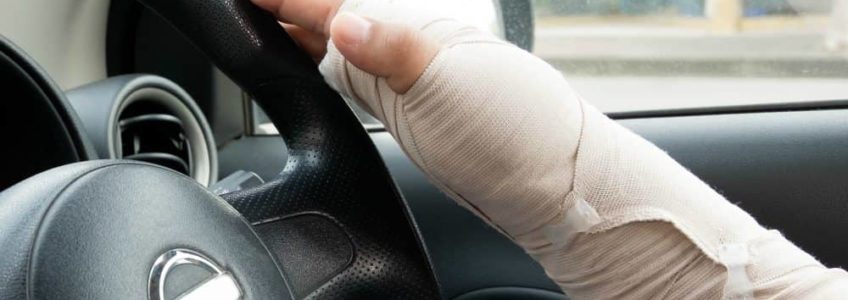
The answer to this question largely depends on the type of orthopedic procedure you undergo. While there is no regulation that prohibits you from driving immediately after surgery, it is your personal responsibility to drive safely and keep not only yourself but others safe while on the road.
Orthopedic procedures can affect patients’ ability to perform activities of daily living, such as driving and cooking that require coordinated use of the upper and lower extremities. Many variables affect the time needed before a patient can drive competently after undergoing orthopedic surgery to the extremities. These variables include whether the patient underwent upper- or lower-extremity surgery; whether the right or left lower extremity is involved; whether the dominant arm is involved; whether the extremity is in a cast or brace; whether the patient is taking pain medication and whether the patient has adequate strength to control the steering wheel.
Patients should be counseled not to drive until they can control the steering wheel and the pedals competently and can drive well enough to prevent further harm to themselves or to others. This review discusses the limited recommendations in the literature regarding driving motorized vehicles after upper- or lower- extremity orthopedic surgery.
Things to Consider Before Driving After Orthopedic Surgery:
Was Anesthesia Used?
It is never a good idea to drive yourself home from surgery, as anesthesia can slow reflexes, slow your thought processes, and can even cause amnesia in the hours following surgery. In fact, you should refrain from driving for the first 24 to 48 hours after receiving anesthesia. In fact, for the first day you should refrain from many things in addition to driving such as operating machinery, cooking (warming in the microwave is ok), and doing any task that could obviously lead to injury.
Prior to your surgery, arrange for transportation home with a friend or family member. This includes driving after any dental procedure that involves sedation or anesthesia, minor outpatient procedures such as a colonoscopy, and same day surgery procedures.
Did You Take Pain Medication?
Following surgery, anesthesia will begin to wear off, which means you will begin taking strong pain medications, especially following joint replacement surgery, which come with side effects. Some types of medication can have effects similar to driving under the influence, where your focus and reaction time may be reduced. If you are not 100% conscious, alert, and clear-headed, it’s best to take an Uber/Lyft or ask someone to drive you home following the orthopedic procedure.
Are You Wearing a Cast, Splint, or Brace in Your Arm or Leg?
An obvious effect of orthopedic surgery is the physical limitations you will have immediately afterward. During this time, you may be wearing a cast or a brace around the body part operated on, such as around the shoulder, arm, hand, leg, knee, or ankle. Immobilization devices can affect your ability to drive, therefore just as when you are taking medication, it is best to leave the driving to someone else.
The use of both arms is essential to safely operate an unmodified vehicle. Drivers in casts tend to have worse responses to hazards in a driving simulator and also drive more cautiously. Drivers wearing a sling were involved in significantly more crashes than those using both arms. Even healthy volunteers wearing a sling had impaired driving ability. It is my recommendation that any patient wearing any form of upper limb splint or sling not operate a motor vehicle.
Are You in Pain?
It is often recommended by surgeons that you wait until you are pain-free before you return to driving. Being pain-free means you are no longer taking pain medication, and your body has healed to the point where pain is no longer an issue. When you drive, you should not be in pain since it can compromise your ability to drive safely.
Medical Liability
Technically speaking, doctors cannot make any determinations regarding the safe operation of a motor vehicle. Despite what some might tell you, your doctor can neither “clear” nor “release” you to drive a car and is in no way liable if you get behind the wheel.
While your doctor can advise you whether operating a vehicle is unsafe, he or she cannot make the legal determination as to whether your driving is actionable under the law. Only a law enforcement officer can do that.
A Safe Return to Driving After Orthopedic Surgery Depends On:
- What you drive (automatic / manual / power steering)
- The conditions you are driving in (bad weather/ night/ poor roads)
- How long the journey will be
- The medications you are taking
- The pain you are experiencing
- The function you have lost
- Your judgement and capacity to drive
A Word From Ventura Orthopedic Today
With all things considered, it is best to leave the driving to someone else immediately following an orthopedic procedure. Patients scheduled to undergo surgery are required to plan ahead for the surgery, which includes making preparations for recovery at home as well as arranging for a safe return home. It is very rare for orthopedic surgeons to recommend that patients drive themselves home after surgery.
The experienced and dedicated orthopedic surgeons at Ventura Orthopedics are here for you. We are committed to helping you through any procedure until optimum health, strength and mobility are restored. Call us today at 800-698-1280 to schedule an appointment.

